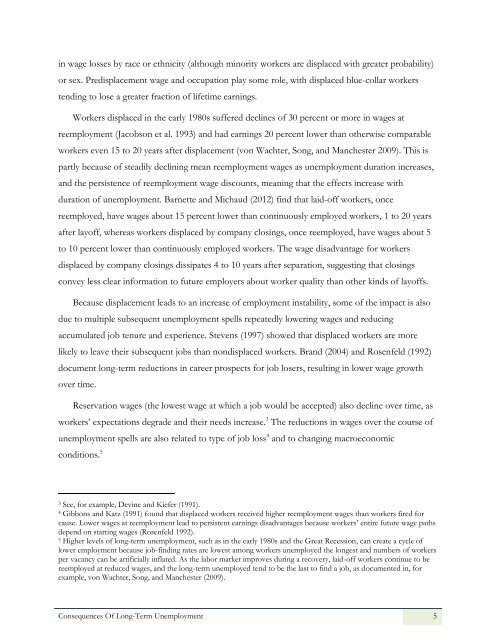Hidden Unemployment
Hidden Unemployment
Hidden Unemployment
Create successful ePaper yourself
Turn your PDF publications into a flip-book with our unique Google optimized e-Paper software.
in wage losses by race or ethnicity (although minority workers are displaced with greater probability)<br />
or sex. Predisplacement wage and occupation play some role, with displaced blue-collar workers<br />
tending to lose a greater fraction of lifetime earnings.<br />
Workers displaced in the early 1980s suffered declines of 30 percent or more in wages at<br />
reemployment (Jacobson et al. 1993) and had earnings 20 percent lower than otherwise comparable<br />
workers even 15 to 20 years after displacement (von Wachter, Song, and Manchester 2009). This is<br />
partly because of steadily declining mean reemployment wages as unemployment duration increases,<br />
and the persistence of reemployment wage discounts, meaning that the effects increase with<br />
duration of unemployment. Barnette and Michaud (2012) find that laid-off workers, once<br />
reemployed, have wages about 15 percent lower than continuously employed workers, 1 to 20 years<br />
after layoff, whereas workers displaced by company closings, once reemployed, have wages about 5<br />
to 10 percent lower than continuously employed workers. The wage disadvantage for workers<br />
displaced by company closings dissipates 4 to 10 years after separation, suggesting that closings<br />
convey less clear information to future employers about worker quality than other kinds of layoffs.<br />
Because displacement leads to an increase of employment instability, some of the impact is also<br />
due to multiple subsequent unemployment spells repeatedly lowering wages and reducing<br />
accumulated job tenure and experience. Stevens (1997) showed that displaced workers are more<br />
likely to leave their subsequent jobs than nondisplaced workers. Brand (2004) and Rosenfeld (1992)<br />
document long-term reductions in career prospects for job losers, resulting in lower wage growth<br />
over time.<br />
Reservation wages (the lowest wage at which a job would be accepted) also decline over time, as<br />
workers’ expectations degrade and their needs increase. 3 The reductions in wages over the course of<br />
unemployment spells are also related to type of job loss 4 and to changing macroeconomic<br />
conditions. 5<br />
3 See, for example, Devine and Kiefer (1991).<br />
4 Gibbons and Katz (1991) found that displaced workers received higher reemployment wages than workers fired for<br />
cause. Lower wages at reemployment lead to persistent earnings disadvantages because workers’ entire future wage paths<br />
depend on starting wages (Rosenfeld 1992).<br />
5 Higher levels of long-term unemployment, such as in the early 1980s and the Great Recession, can create a cycle of<br />
lower employment because job-finding rates are lowest among workers unemployed the longest and numbers of workers<br />
per vacancy can be artificially inflated. As the labor market improves during a recovery, laid-off workers continue to be<br />
reemployed at reduced wages, and the long-term unemployed tend to be the last to find a job, as documented in, for<br />
example, von Wachter, Song, and Manchester (2009).<br />
Consequences Of Long-Term <strong>Unemployment</strong> 5

















